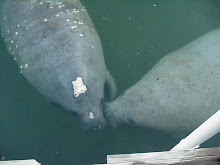At the turn of the century the United States had many communal societies being founded. One such communal society, The Koreshan Unity, was founded in 1894 in Estero, Florida. Estero is just south of us and where Yam went to college. Yam had been to the Koreshan State Historic Site a couple of times before but joined The Colonel and I for our first visit (Yam said she had been there enough times to now be considered an "Honorary Koreshan"). A couple of weeks later The Colonel, Yam, My-Favorite-Father/Mother-In-Law, My-Darling-Sister-In-Law and I visited the site together (maybe I am on my way to becoming an Honorary Koreshan too).
Dr. Cyrus Teed or Koresh (Hebrew for Cyrus) formed the Koreshan Unity in 1886 in Chicago and brought his followers called Koreshans to Estero, Florida in 1894. It was here that a new community was to be established and this new community was to be the New Jerusalem.
The Koreshan Unity was founded upon the ideas of communal living and property. It was to be a Utopia; a life without crime, tobacco, drugs or alcohol. Every member would work for the good of all.
Those who joined the Koreshan Unity were promised security, order and a sense of achievement. Economically, all needs were met and financial security was assured. Religiously, it was a return to Christianity (or as Dr. Teed called it, Koreshanity) as it was "meant to be". Socially, it provided classic education with vocational training. Scientifically, it offered a universe that was finite and understandable. Equality among the sexes was ordained and everyone had a job and place in life.
Those who came to Estero found it a test of their courage and ability. They left their safe, comfortable, mostly upper-middle class lives to begin a new one in a hot, humid, bug-infested wilderness. Their faith in Dr. Teed and his teachings was great. The new Koreshans brought their furnishings, books and even a grand piano to their new home.
At the turn of the century the colony had around 200 members; many coming from Chicago. There was a laundry, machine shop, bakery/dormitory, dining hall, art hall and housing for the seven women who managed the Unity. The house was called the Planetary Court.
Dr. Teed had his own house.
This is the Art Hall where the Koreshans gave musicals, plays and lectures.
Inside the Art Hall was a display of a globe that supported the Koreshan belief of a hollow earth existence. The globe still works today and spins.
There was a Unity school that the children of the Koreshans attended.
The Unity also had its own publishing business. They published books, pamphlets, periodicals and leaflets. It was highly successful and was one of the best printing and binding establishments in the state at the time.
The Koreshan Unity also had a store and a boat building business. They had a large garden that fed them as well as financially supported them as they sold what they grew.
By 1906 the Koreshan community was in decline. There were several reasons why this happened. Estero was incorporated and the officials in nearby Fort Myers did not want to divert their tax revenues to support Estero projects. The Koreshan beliefs made those in nearby areas uncomfortable. Some of the Koreshan members wanted to enter into the local political scene which also made many outside the Unity angry. In 1906, Ross Wallace, a Koreshan candidate for the County Commission, was involved in an altercation with a Mr. Sellers in Fort Myers. Dr. Teed happened to be in town awaiting the arrival of new Koreshan members. Mr. Sellers became violent and struck Dr. Teed several times in the face and head. The marshal did not intervene. In fact, the marshal also struck Dr. Teed. Two years later, in December of 1908, Dr. Teed died from complications of the severe beating.
Dr. Teed told his followers that he would rise up from the dead three days after he died. The followers placed his body in a bathtub and waited to see the miracle happen. Three days passed in the warm Florida climate and still no resurrection took place. Eventually Teed's body had to be buried.
After Teed's death the Unity and its community began to slowly dwindle. The final Koreshan to live there was Hedwig Michel.
Hedwig passed away in 1982 and is buried on the grounds of the Koreshan State Historic Park.
Many people hold their wedding ceremonies at the park. The grounds are beautiful. It was lovely walking around and taking pictures.
There is a large bamboo garden that you can walk through. The bamboo creaks as the breeze blows through the stands.
This is the Bamboo Landing along the Estero River followed by a picture of Estero River.
Many pretty things to see...
There was a sausage tree on the park grounds. It is an interesting tree. The "sausages" hang down from long vines. There were sausages on the ground. Yam is holding one and she said it was a bit heavy.
This is a lovely place to visit and I liked learning about the Koreshan Unity's history. I think my favorite part was the beautiful Planetary Court house. We were able to take a tour inside (lower floor only). The woodwork inside was beautiful and impressive. I loved the built-in bench in front of the stairs.
The bedrooms were simple, yet pretty. Each bedroom had its own door to the outside.
Dr. Teed's house was a bit more fancy inside yet plainer on the outside than the Planetary Court.
The Koreshan Unity Settlement and State Historic Park is a must see if you are ever in the Estero, Florida area.





































































He looks kind of like the Swede on AMC's Hell on Wheels.
ReplyDeleteGood blog Sister-Michael